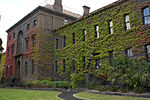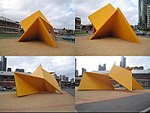Repatriation Commission Outpatient Clinic

The Repatriation Commission Outpatient Clinic at 310 St Kilda Road, Melbourne, Australia, is an Art Deco building of architectural and historical significance as the only remaining Repatriation Commission Outpatient Clinic or Commonwealth building built for the health and wellbeing of the original ANZACs (i.e., World War I veterans). Significantly the building was constructed for the ANZACs of World War I nearly 20 years after the end of the war. The clinic subsequently supported the wellbeing of veterans of World War II, Korean War and Vietnam War. The Australian veteran community consider it a sacred place due to the connection to the suffering of veterans returned from those wars.
Excerpt from the Wikipedia article Repatriation Commission Outpatient Clinic (License: CC BY-SA 3.0, Authors, Images).Repatriation Commission Outpatient Clinic
Coventry Street, Melbourne Southbank
Geographical coordinates (GPS) Address Nearby Places Show on map
Geographical coordinates (GPS)
| Latitude | Longitude |
|---|---|
| N -37.828492 ° | E 144.9709 ° |
Address
Repatriation Building
Coventry Street
3006 Melbourne, Southbank
Victoria, Australia
Open on Google Maps










